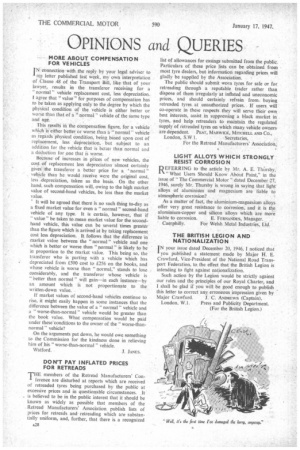OPINIONS and
Page 30

If you've noticed an error in this article please click here to report it so we can fix it.
UERIES
MORE ABOUT COMPENSATION FOR VEHICLES
JN connection with the reply by your legal adviser to my letter published last week, my own interpretation of Clause 48 of the Transport Bill, like that of your lawyer, results in the transferor receiving for a " normal " vehicle replacement cost, less depreciation. agree that " value " for purposes of compensation has to be taken as applying only to the degree by which the physical condition of the vehicle is either better or worse than that of a " normal " vehicle of the same type
and age. • This results in the compensation figure, for a vehicle which is either better or worse than a " normal " vehicle as regards physical condition, being based upon cost of replacement, less depreciation, but subject to an addition for the vehicle that is better than normal and a deduction for one that is worse.
Because of increases in prices of new vehicles, the cost of replacement less depreciation almost certainly gives the transferor a better price for a 'normal " vehicle than he would receive were the original cost, less .depreciation, taken as the basis. On the other hand, such compensation will, owing to the high market value of second-hand vehicles, be less than the market value.
' It will be agreed that there is no such thine to-day as a fixed market value for even a " normal " second-hand vehicle of any type. It is certain, however, that if value" be taken to mean market value for the secondhand vehicle, this value can be several times greater than the figure which is arrived at by taking replacement cost less depreciation. It follows that the difference in market value between the " normal " vehicle and one which is better or worse than " normal " is likely to be in proportion to the market value. This being so, the transferor who is parting with a vehicle which has depreciated from £500 cost to £256 on the books, and whose vehicle is worse than "normal," stands to lose considerably, and the transferor whose vehicle is "better than normal" will gain—in each instance—by an amount which is not proportionate to the written-down value.
If market values of second-hand vehicles continue to rise, it might easily happen in some instances that the difference between the value of a " normal " vehicle and a " worse-than-normal " vehicle would be greater than the book value. What compensation would be paid under these conditions to the owner of the " worse-thannormal " vehicle?
On the arguments put down, he would owe something to the Commission for the kindness done in relieving him of his " worse-than-normal " vehicle.
Watford. 3. JANES,
DON'T PAY INFLATED PRICES FOR RETREADS
THE members of the Retread Manufacturers' Conference are disturbed at reports which are received of retreaded tyres being purchased by the public at excessive prices and in questionable circumstances. It
_ is believed to be in the public interest that it should be known as widely as possible that members of the Retread Manufacturers' Association publish lists of prices for retreads and retreading which are substantially uniform, and, further, that there is a recognized list of allowances for casings submitted from the public. Particulars of these price lists can be obtained from most tyre dealers, but information regarding prices will gladly be supplied by the Association.
The public should submit worn tyres for sale or for retreading through a reputable trader rather than dispose of them irregularly at inflated and uneconomic prices, and should certainly refrain from buying retreaded tyres at unauthorized prices. If users will co-operate in these respects they will serve their own best interests, assist in suppressing a black market in tyres, and help retreaders to maintain the regulated supply of retreaded tyres on which many vehicle owners are dependent. PEAT, MARWICK, MITCHELL AND CO.,
London, SW 1. Secretaries, For the Retread Manufacturers' Association: LIGHT ALLOYS WHICH STR0NGLY RESIST CORROSIO N
REFERRING to the article by Mr. A. E. Thiirsby, "What Users Should Know About Paint," in the issue of "The Commercial Motor" dated December 27, 1946, surely Mr. Thursby is wrong in saying that light alloys of aluminium and magnesium are liable to atmospheric corrosion?
As a matter of fact, the aluminium-magnesium alloys offer very great resistance to corrosion, and it is the aluminium-copper and silicon alloys which are more
liable to corrosion. E. FERNANDES, Manager.
Caerphilly. For Welsh Metal Industries, Ltd.
THE BRITISH LEGION AND NATIONALIZATION
JN your issue dated December 20, 1946, I noticed that you published a statement made by Major H. E. Crawfurd, Vice-President of the National Road Transport Federation, to the effect that the British Legion is intending to fight against nationalization.
Such action by the Legion would be strictly against our rules and the principles of our Royal Charter, and I shall be glad if you will be good enough to publish this letter to correct any, erroneous impression given by
Major Crawfurd. J. C. ANDREWS (Captain),
London, W.1. Press and Publicity Department.
(For the British Legion.)












































































